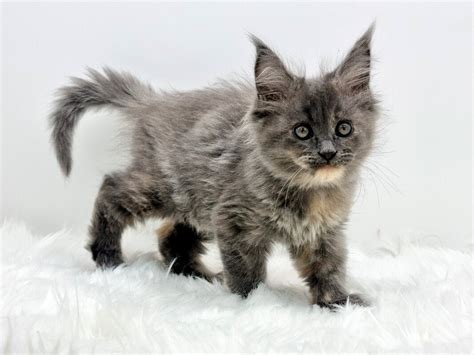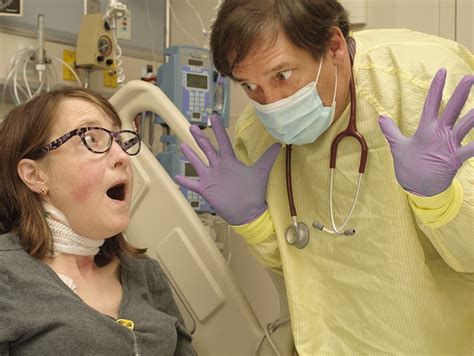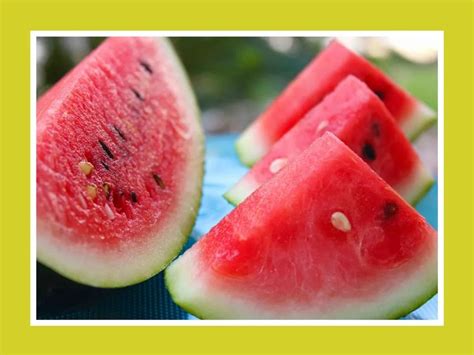
A rare blue tortie Maine Coon is captivating audiences online with its unique coloring and striking appearance, quickly becoming an internet sensation.
A Maine Coon cat sporting an exceptionally rare “blue tortie” coat has captured the hearts of online viewers, garnering significant attention for its unusual and beautiful appearance. The feline’s distinctive fur, a mix of blue-gray and orange-red hues, is a genetic anomaly that sets it apart from typical Maine Coons and other cats. This extraordinary coloring, combined with the breed’s already impressive size and fluffy coat, has propelled the cat to viral fame.
The “blue tortie” coloration arises from a combination of genetic factors linked to the X chromosome. In cats, the gene responsible for black and orange pigment is located on the X chromosome. Females, possessing two X chromosomes (XX), can express both black and orange, leading to tortoiseshell patterns. “Blue,” in feline color genetics, refers to a dilution of black, resulting in a gray-blue shade. Therefore, a “blue tortie” cat exhibits a mix of this blue-gray and orange-red, creating a visually striking patchwork effect. Male cats, with only one X chromosome (XY), typically display either black or orange, but rarely both unless they have a rare chromosomal abnormality (XXY), which usually renders them sterile. The rarity of the blue tortie pattern, therefore, is largely attributed to the genetics of sex-linked traits and the requirement for specific combinations to manifest.
Maine Coons are one of the largest domesticated cat breeds, known for their friendly demeanor, intelligence, and distinctive physical characteristics. Originating in the state of Maine, they are often referred to as “gentle giants” due to their size and affectionate nature. Male Maine Coons can weigh between 13 to 18 pounds or more, while females typically weigh between 8 to 12 pounds. Their thick, shaggy fur provides insulation against harsh winters, and their bushy tails aid in balance. Maine Coons come in a variety of colors and patterns, but the blue tortie is among the rarest and most sought-after.
The viral sensation serves as a reminder of the incredible diversity and complexity of feline genetics. Cat enthusiasts and breeders alike are often fascinated by the unusual color combinations and patterns that can emerge through specific genetic pairings. The blue tortie Maine Coon’s popularity also underscores the enduring appeal of cats as pets and the internet’s ability to amplify their charm.
The unique coloring has not only made the cat an internet celebrity but also sparked interest in feline genetics and the science behind coat color determination. Experts emphasize that understanding these genetic mechanisms is crucial for responsible breeding practices and maintaining the health and well-being of cats.
The visual appeal of the blue tortie Maine Coon is undeniable. The contrast between the cool blue-gray and warm orange-red tones creates a captivating effect that draws the eye. The cat’s thick, luxurious fur further enhances its beauty, making it a standout among its peers. This striking appearance, coupled with the breed’s already impressive size and regal bearing, contributes to its overall allure.
Beyond its aesthetic qualities, the blue tortie Maine Coon’s popularity also highlights the growing appreciation for rare and unique animals. In a world where mass production and standardization are prevalent, there is an increasing desire for individuality and authenticity. Animals with unusual traits or characteristics often capture our attention because they represent a departure from the norm.
The internet has played a significant role in the blue tortie Maine Coon’s rise to fame. Social media platforms like Instagram, TikTok, and Facebook provide a global stage for showcasing animals with exceptional qualities. Viral videos and photos can quickly spread across the internet, reaching millions of viewers in a matter of hours. This widespread exposure can lead to increased recognition and appreciation for the animal in question.
The popularity of the blue tortie Maine Coon also has implications for breeders and cat enthusiasts. Breeders may seek to reproduce the rare coloring through selective breeding programs, while enthusiasts may be willing to pay a premium for a cat with this unique coat pattern. However, it is important to note that breeding for specific traits can sometimes lead to unintended consequences, such as increased risk of genetic disorders or health problems. Responsible breeders prioritize the health and well-being of their cats above all else.
The Maine Coon breed itself has a rich history and a devoted following. These cats are known for their gentle nature, intelligence, and playful personalities. They are often described as “dogs of the cat world” due to their tendency to follow their owners around and participate in household activities. Maine Coons are also known for their distinctive vocalizations, which range from soft chirps to loud meows.
The breed’s origins can be traced back to the state of Maine in the 19th century. According to legend, Maine Coons are descended from domestic cats that mated with wild bobcats. While this is genetically impossible, it speaks to the breed’s rugged appearance and adaptability to harsh climates. Maine Coons were originally working cats, valued for their ability to control rodent populations on farms and in homes. Over time, they became popular as companion animals and show cats.
The breed was officially recognized by the Cat Fanciers’ Association (CFA) in 1903. Today, Maine Coons are one of the most popular cat breeds in the world, known for their affectionate personalities and striking appearance. They are often chosen as family pets due to their gentle nature and ability to get along with children and other animals.
The blue tortie Maine Coon’s popularity also highlights the broader trend of pet ownership and the role that animals play in our lives. Pets provide companionship, emotional support, and a sense of purpose. They can also help to reduce stress and improve overall well-being. The bond between humans and animals is a powerful one that has been recognized for centuries.
The internet has also created new opportunities for pet owners to connect with one another and share their experiences. Online communities and social media groups dedicated to specific breeds or types of animals provide a platform for sharing information, advice, and support. These communities can be a valuable resource for pet owners who are looking to learn more about their animals or connect with others who share their passion.
The blue tortie Maine Coon is just one example of the many unique and fascinating animals that exist in the world. By celebrating these creatures and learning more about their genetic makeup, we can gain a deeper appreciation for the diversity of life on Earth. The cat’s viral fame serves as a reminder of the power of the internet to connect people and share stories about the things that matter most to them, including the animals that enrich our lives.
The genetics behind feline coat colors are intricate, involving multiple genes that interact to produce a wide range of colors and patterns. The primary gene responsible for black and orange pigment is located on the X chromosome, as previously mentioned. This gene has two alleles: one for black pigment and one for orange pigment. Females, with two X chromosomes, can express both alleles, resulting in tortoiseshell or calico patterns.
The “dilute” gene is another important factor in feline coat color. This gene modifies the expression of black pigment, causing it to appear as blue (gray-blue) instead. Similarly, the dilute gene can affect orange pigment, causing it to appear as cream or buff. The combination of the dilute gene with the black and orange genes creates the blue tortie pattern.
Other genes can also influence feline coat color, including genes that control the distribution of pigment within the hair shaft, the presence of white spotting, and the overall intensity of color. These genes can interact in complex ways to produce a seemingly endless variety of colors and patterns.
Understanding the genetics of feline coat color is not only fascinating from a scientific perspective but also has practical applications for breeders and cat enthusiasts. By understanding the genetic basis of different colors and patterns, breeders can make informed decisions about which cats to breed in order to produce offspring with desired traits.
However, it is important to note that breeding for specific traits can sometimes lead to unintended consequences. For example, some genetic mutations that cause desirable coat colors or patterns can also be associated with health problems. Responsible breeders prioritize the health and well-being of their cats above all else and avoid breeding cats with known genetic disorders.
The blue tortie Maine Coon’s viral fame also raises questions about the ethics of breeding for specific traits. Some argue that breeding for aesthetic purposes is unethical because it can lead to the exploitation of animals and the perpetuation of harmful genetic mutations. Others argue that responsible breeding can be a way to preserve and celebrate the diversity of animal species.
Ultimately, the decision of whether or not to breed for specific traits is a personal one. However, it is important to consider the potential consequences of breeding and to prioritize the health and well-being of the animals involved.
The Maine Coon breed has a long and fascinating history. These cats are believed to have originated in the state of Maine in the 19th century. There are several theories about their origins. One theory suggests that they are descended from domestic cats that were brought to Maine by sailors. Another theory suggests that they are descended from domestic cats that mated with wild bobcats. While the latter is genetically impossible, the legend persists and contributes to the breed’s mystique.
Regardless of their exact origins, Maine Coons quickly became popular as working cats on farms and in homes. They were valued for their ability to control rodent populations and their hardy nature. Over time, they also became popular as companion animals and show cats.
The breed was officially recognized by the Cat Fanciers’ Association (CFA) in 1903. However, their popularity waned in the early 20th century as other breeds gained prominence. In the 1950s, a group of Maine Coon enthusiasts formed the Maine Coon Cat Club and began working to revive the breed.
Today, Maine Coons are one of the most popular cat breeds in the world. They are known for their gentle nature, intelligence, and playful personalities. They are often chosen as family pets due to their affectionate nature and ability to get along with children and other animals.
Maine Coons are also known for their distinctive physical characteristics. They are one of the largest domesticated cat breeds, with males typically weighing between 13 and 18 pounds or more, and females weighing between 8 and 12 pounds. They have thick, shaggy fur that provides insulation against harsh winters, and bushy tails that aid in balance.
Maine Coons come in a variety of colors and patterns, but the blue tortie is among the rarest and most sought-after. Other popular colors include brown tabby, red tabby, black, and white.
The breed’s popularity has led to increased demand for Maine Coon kittens. However, it is important to purchase kittens from reputable breeders who prioritize the health and well-being of their cats. Responsible breeders will screen their cats for genetic disorders and provide proper care and socialization for their kittens.
The blue tortie Maine Coon’s viral fame is a testament to the enduring appeal of cats as pets and the power of the internet to connect people and share stories. The cat’s unique coloring and striking appearance have captured the hearts of viewers around the world, and its popularity serves as a reminder of the diversity and beauty of the animal kingdom.
The story of this captivating feline underscores several broader trends in society, including the increasing appreciation for rare and unique animals, the growing importance of pets in our lives, and the transformative power of the internet to connect people and share information. As we continue to learn more about the genetics and behavior of animals, we can gain a deeper understanding of the world around us and the importance of protecting biodiversity.
The viral sensation has sparked discussions about responsible pet ownership, ethical breeding practices, and the role of social media in shaping our perceptions of animals. These are important conversations to have as we strive to create a more humane and sustainable world for all creatures.
Ultimately, the blue tortie Maine Coon’s story is a heartwarming reminder of the joy and companionship that animals bring to our lives. Whether it’s a rare and beautiful cat or a humble mutt, pets have a way of enriching our lives and reminding us of the simple pleasures in life.
The cat’s rise to internet stardom is a prime example of how social media can amplify the appeal of animals with unique traits. Platforms like Instagram, TikTok, and Facebook provide a vast audience for showcasing these animals, leading to widespread recognition and admiration. The blue tortie Maine Coon’s captivating appearance, combined with the power of social media, has created a viral phenomenon that has captured the attention of millions.
The popularity of the blue tortie Maine Coon also highlights the growing trend of pet humanization. As pets become increasingly integrated into our families, we tend to attribute human-like qualities and emotions to them. This trend is reflected in the way we talk about our pets, the products we buy for them, and the activities we engage in with them.
Pet humanization can have both positive and negative consequences. On the one hand, it can lead to increased empathy and compassion for animals. On the other hand, it can lead to unrealistic expectations and a failure to recognize the unique needs of different species.
It is important to remember that pets are not humans and that they have their own distinct needs and behaviors. By understanding these needs and behaviors, we can provide better care for our pets and build stronger relationships with them.
The blue tortie Maine Coon’s story is a reminder of the importance of responsible pet ownership. Responsible pet owners provide their animals with proper food, shelter, and veterinary care. They also ensure that their animals are properly socialized and trained.
Responsible pet ownership is not only beneficial for the animals involved but also for the community as a whole. Well-cared-for and well-behaved pets are less likely to cause problems for their neighbors and are more likely to be welcomed in public spaces.
The blue tortie Maine Coon’s viral fame also raises questions about the ethics of animal breeding. Some argue that breeding for specific traits is unethical because it can lead to the exploitation of animals and the perpetuation of harmful genetic mutations. Others argue that responsible breeding can be a way to preserve and celebrate the diversity of animal species.
Ultimately, the decision of whether or not to breed for specific traits is a personal one. However, it is important to consider the potential consequences of breeding and to prioritize the health and well-being of the animals involved.
The blue tortie Maine Coon’s story is a testament to the enduring appeal of cats as pets and the power of the internet to connect people and share stories. The cat’s unique coloring and striking appearance have captured the hearts of viewers around the world, and its popularity serves as a reminder of the diversity and beauty of the animal kingdom.
The story of this captivating feline underscores several broader trends in society, including the increasing appreciation for rare and unique animals, the growing importance of pets in our lives, and the transformative power of the internet to connect people and share information. As we continue to learn more about the genetics and behavior of animals, we can gain a deeper understanding of the world around us and the importance of protecting biodiversity.
Frequently Asked Questions (FAQ)
1. What is a blue tortie Maine Coon and what makes it so rare?
A blue tortie Maine Coon is a Maine Coon cat with a coat color pattern that combines blue-gray (a diluted form of black) and orange-red hues. This coloration is rare because it requires a specific combination of genetic factors related to the X chromosome. Female cats have two X chromosomes and can express both black and orange, leading to tortoiseshell patterns. The “blue” color is a dilution of black. Therefore, a blue tortie exhibits a mix of blue-gray and orange-red. Male cats typically have only one X chromosome and usually display either black or orange. A male with a tortie pattern is extremely rare and usually has a chromosomal abnormality (XXY) that renders them sterile. The combination of these factors makes the blue tortie pattern uncommon, especially in the Maine Coon breed.
2. Are there any specific health concerns associated with the blue tortie coloration in Maine Coons?
There are no specific health concerns directly linked to the blue tortie coloration itself. The color is a result of genetic expression and doesn’t inherently predispose the cat to any particular health issues. However, it’s important to ensure that the cat comes from a reputable breeder who screens for common Maine Coon health problems such as hip dysplasia, hypertrophic cardiomyopathy (HCM), and spinal muscular atrophy (SMA). These conditions are associated with the breed in general, not specifically with the blue tortie color.
3. How much does a blue tortie Maine Coon kitten typically cost?
The cost of a blue tortie Maine Coon kitten can vary significantly depending on several factors, including the breeder’s reputation, the kitten’s lineage, and the overall demand for the color pattern. Generally, rare colors like blue tortie can command a higher price than more common colors. You can expect to pay anywhere from $2000 to $5000 or more for a blue tortie Maine Coon kitten from a reputable breeder. It’s crucial to research breeders thoroughly and prioritize health and temperament over color when choosing a kitten.
4. How can I find a reputable breeder of blue tortie Maine Coons?
Finding a reputable breeder requires careful research and due diligence. Start by contacting Maine Coon breed clubs and associations, such as the Maine Coon Cat Club (MCCC), for breeder referrals. Look for breeders who are transparent about their breeding practices, provide health guarantees for their kittens, and allow you to visit their cattery. A reputable breeder will also be knowledgeable about the breed’s health issues and will be willing to answer your questions thoroughly. Avoid breeders who seem primarily motivated by profit or who are unwilling to provide detailed information about their cats.
5. What are the general care requirements for a Maine Coon cat?
Maine Coons are relatively low-maintenance cats, but they do require regular care to stay healthy and happy. Their long, thick fur needs to be brushed several times a week to prevent mats and tangles. Regular nail trimming and dental care are also important. Maine Coons are intelligent and active cats, so they need plenty of opportunities for play and exercise. Provide them with scratching posts, toys, and climbing structures to keep them entertained. A high-quality diet is essential for maintaining their overall health. Regular veterinary checkups are also important for detecting and addressing any health issues early on. Since Maine Coons are large cats, ensure they have adequate space and resources like large litter boxes and sturdy cat trees.









